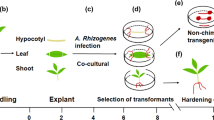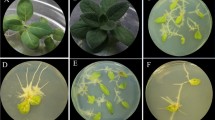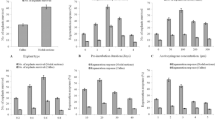Abstract
We obtained transformed root cultures for the scented, “lemon geranium (Pelargonium sp.) by inoculating stem and leaf fragments with Agrobacterium rhizogenes. Shoots regenerated spontaneously from transformed roots and contained the TL– and TR–DNAs (left–hand and right–hand transferred DNAs) from the Ri (root–inducing) plasmid. The transformed phenotype included shorter stature, increased leaf and branch production, accelerated rooting of cuttings, altered root system architecture, inhibition of ftowering and increased production of geraniol and other aromatic substances. We discuss applications of this phenotype in improving the ornamental quality of scented geraniums and increasing the production of their essential oils.
This is a preview of subscription content, access via your institution
Access options
Subscribe to this journal
Receive 12 print issues and online access
$209.00 per year
only $17.42 per issue
Buy this article
- Purchase on Springer Link
- Instant access to full article PDF
Prices may be subject to local taxes which are calculated during checkout
Similar content being viewed by others
References
Tepfer, D. 1989. Ri T-DNA from Agrobacterium rhizogenes: a source of genes having applications in rhizosphere biology and plant development, ecology and evolution, p. 294–342. In: Plant-Microbe Interactions, T. Kosuge, E. Nester (Eds.). McGraw-Hill, New York.
Tepfer, D. and Tempé, J. 1981. Production d'agropine par des racines formées sous 1'action d'Agrobacterium rhizogenes, souche A4. C. R. Acad. Sci. 292: 153–156.
Tepfer, D. 1982. La transformation génétique de plantes supérieures par Agrobacterium rhizogenes, 47–59. In: 2e Colloque sur les Recherches Fruitières, (Eds.). Centre Technique Interprofessionnel des Fruits et Légumes, Bordeaux.
Tepfer, D. 1984. Transformation of several species of higher plants by Agrobacterium rhizogenes: sexual transmission of the transformed genotype and phenotype. Cell 47: 959–967.
Tepfer, D. 1983. The potential uses of Agrobacterium rhizogenes in the genetic engineering of higher plants: nature got there first, p. 153–164. In: Genetic Engineering in Eukaryotes, P. Lurquin, A. Kleinhofs (Eds.). Plenum Press, New York.
Slightom, J., Durand-Tardif, M., Jouanin, L. and Tepfer, D. 1986. Nucleotide sequence analysis of TL-DNA of Agrobacterium rhizogenes agropine type plasmid. J. Biol. Chem. 261: 108–121.
Ravid, U. and Putievsky, E. 1984. The influence of harvest dales and leaf location on the essential oil content and major components of Pelargonium graveolens L. Acta Hort. 144: 159–165.
Jung, G. and Tepfer, D. 1987. Use of genetic transformation by the Ri T-DNA of Agrobacterium rhizogenes to stimulate biomass and tropane alkaloid production in Atropa belladonna and Calystegia sepium roots. Plant Science 50: 145–151.
Kennedy, A.I., Deans, S.G., Svoboda, K.P., Gray, A.I. and Waterman, P.G. 1993. Volatile oils from normal and transformed root of Artemisia absinthium. Phytochemistry 32: 1449–1451.
Maldonadomendoza, I.E., Ayoratalavera, T. and Loyolavargas, V.M. 1993. Establishment of hairy root cultures of Datura stramonium—characterization and stability of tropane alkaloid production during long periods of subculturing. Plant Cell Tissue Organ Cult. 33: 321–329.
Ooms, G., Atkinson, J., Bossen, M. and Leigh, R. 1986. TL-DNA from Agrobacterium rhizogenes plasmid pRi1855 reduces osmotic pressure in transformed plants grown in vitro. Planta 168: 106–112.
Maurel, C., Barbierbrygoo, H., Spena, A., Tempé, J. and Guern, J. 1991. Single rol genes from the Agrobacterium rhizogenes TL-DNA alter some of the cellular responses to auxin in Nicotiana tabacum. Plant Physiol. 97: 212–216.
Schmulling, T., Rohrig, H., Pilz, S., Walden, R. and Schell, J. 1993. Restoration of fertility by antisense RNA in genetically engineered male sterile tobacco plants. Mol. Gen. Genet. 37: 385–394.
Martin-Tanguy, J., Corbineau, F., Burtin, D., Ben-Hayyim, G. and Tepfer, D. 1993. Genetic transformation with a derivative of rolC from Agrobacterium rhizogenes and treatment with α-aminoisobutyric acid produce similar phenotypes and reduce ethylene production and the accumulation of water-insoluble polyamine-hydroxycinnamic acid conjugates in tobacco flowers. Plant Science. In press.
Estruch, J., Chriqui, D., Grossmann, K., Schell, J. and Spena, A. 1991. The plant oncogene rolC is responsible for the release of cytokinins from glucoside conjugates. EMBO J. 10: 2889–2895.
Estruch, J., Schell, J. and Spena, A. 1991. The protein encoded by the rolB plant oncogene hydrolyses indole glucosides. EMBO J. 10: 3125–3128.
Lambert, C. and Tepfer, D. 1992. Use of Agrobacterium rhizogenes to create transgenic apple trees having an altered organogenic response to hormones. Theor. Appl. Genet. 85: 105–109.
Smulders, M.J., Croes, A., Kemp, A., Hese, K., Harren, F. and Wullems, G. 1991. Inhibition by ethylene of auxin promotion of flower bud formation in tobacco explants is absent in plants transformed by Agrobacterium rhizogenes. Plant Physiol. 96: 1131–1135.
Martin-Tanguy, J., Tepfer, D., Paynot, M., Burtin, D., Heisler, L. and Martin, C. 1990. Inverse relationship between polyamine levels and the degree of phenotypic alteration induced by the Ri TL-DNA from Agrobacterium rhizogenes. Plant Physiol. 92: 912–918.
Michael, A., Burtin, D., Martin-Tanguy, J. and Tepfer, D. 1990. Effects of the rolC locus from the Ri TL-DNA of Agrobacterium rhizogenes on development and polyamine metabolism in tobacco, p. 863–868. In: GIM 90 Proceedings, H. Helsot, J. Davis, J. Florint, L. Bobichon, G. Durand, L. Penasse (Eds.). Société Francaise de Microbiologie. Paris.
Burtin, D., Martin-Tanguy, J. and Tepfer, D. 1991. α-DL-difluoromethy-lornithine, a specific, irreversible inhibitor of putrescine biosynthesis, induces a phenotype in tobacco similar to that ascribed to the root-inducing, left-hand transferred DNA of Agrobacterium rhizogenes. Plant Physiol. 95: 461–468.
Sun, L.-Y., Monneuse, M.-O., Martin-Tanguy, J. and Tepfer, D. 1991. Changes in flowering and accumulation of polyamines and hydroxycinnamic acid-polyamine conjugates in tobacco plants transformed by the rolA locus from the Ri TL-DNA of Agrobacterium rhizogenes. Plant Sci. 80: 145–146.
Mengoli, M., Chriqui, D. and Bagni, N., 1992. Protein, free amino acid and polyamine contents duling development of hairy root Nicotiana tabacum plants. J. Plant Physiol. 139: 697–702.
Mengoli, M., Chiriqui, D. and Bagni, N. 1992. Putrescine biosynthesis and oxidation in normal and hairy root tobacco plants. J. Plant Physiol. 140: 153–155.
White, F., Garfinkel, D., Huffman, G., Gordon, M. and Nester, E. 1983. Sequences homologous to Agrobacterium rhizogenes T-DNA in the genomes of uninfected plants. Nature 301: 348–350.
Furner, I., Huffman, G., Amasino, R., Garfunkel, D., Gordon, M. and Nester, E. 1986. An Agrobacterium transformation in the evolution of the genus Nicotiana. Nature 319: 422–427.
Oono, Y., Handa, T., Kanaya, K. and Uchimiya, H., 1987. The TL-DNA gene of Ri plasmids responsible for dwarfhess of tobacco plants. Japan. J. Genet. 62: 501–505.
Cardarelli, M., Mariotti, D., Pomponi, M., Spano, L., Capone, I. and Costantino, P. 1987. Agrobacterium rhizogenes T-DNA genes capable of inducing hairy root phenotype. Mol. Gen. Genet. 209: 475–480.
Schmülling, T., Schell, J. and Spena, A. 1988. Single genes from Agrobacterium rhizogenes influence plant development. EMBO J. 7: 2621–2629.
Spena, A., Estruch, J.J., Prinsen, E., Nacken, W., Vanonckelen, H. and Sommer, H. 1992. Anther-specific expression of the rolB gene of Agrobacterium rhizogenes increases IAA content in anthers and alters anther development and whole flower growth. Theor. Appl. Genet. 4: 520–527.
Vilaine, F., Charbonnier, C. and Casse-Delbart, F., 1987. Further insight concerning the TL-region of the Ri plasmid of Agrobacterium rhizogenes strain A4: transfer of a 1.9 kb fragment is sufficient to induce transformed roots on tobacco leaf fragments. Mol. Gen. Genet. 210: 111–115.
Petit, A., David, C., Dahl, G., Ellis, J., Guyon, P., Casse-Delbart, F. and Tempé, J. 1983. Further extension of the opine concept: plasmids in Agro-bacterium rhizogenes co-operate for opine degradation. Mol. Gen. Genet. 190: 204–214.
Murashige, T. and Skoog, F. 1962. A revised medium for rapid growth and bioassays with tobacco tissue cultures. Physiol. Plant. 15: 473–497.
Collins, G. and Symons, R. 1992. Extraction of nuclear DNA from grape vine leaves by a modified procedure. Plant Mol. Biol. Reporter 10: 233–235.
Southern, E. 1975. Detection of specific sequences among DNA fragments separated by gel electrophoresis. J. Mol. Biol. 98: 503–517.
Jouanin, L. 1984. Restriction map of an agropine-type Ri plasmid and its homologies with Ti plasmids. Plasmid 12: 91–102.
Ivanova, L. and Gorgiya, V. 1973. Dynamics of essential oil accumulation in several geranium species. Subtorop. Kul't 1: 160–164.
Author information
Authors and Affiliations
Rights and permissions
About this article
Cite this article
Pellegrineschi, A., Damon, JP., Valtorta, N. et al. Improvement of Ornamental Characters and Fragrance Production in Lemon-scented Geranium Through Genetic Transformation by Agrobacterium rhizogenes. Nat Biotechnol 12, 64–68 (1994). https://doi.org/10.1038/nbt0194-64
Received:
Accepted:
Issue Date:
DOI: https://doi.org/10.1038/nbt0194-64
This article is cited by
-
Overcoming seed dormancy of Taxus baccata L. by embryo rescue leads to germination and seedling growth
Acta Physiologiae Plantarum (2023)
-
Genetic engineering and sustainable production of ornamentals: current status and future directions
Plant Cell Reports (2012)



